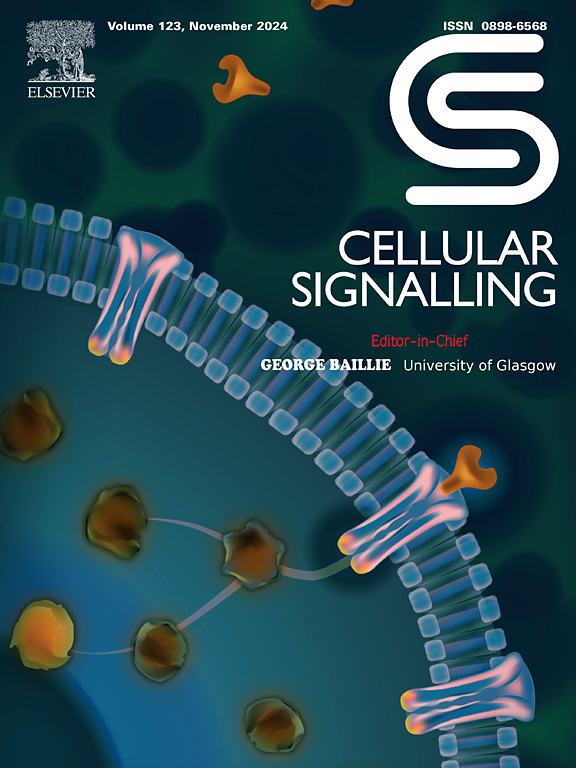方棘霉素通过靶向 FOXM1-ADAM17 轴抑制肝细胞癌转移并减少炎症诱导的上皮-间质转化
IF 4.4
2区 生物学
Q2 CELL BIOLOGY
引用次数: 0
摘要
肝细胞癌(HCC)是全球癌症相关死亡的主要原因。人们一直致力于开发新的抗 HCC 药物并了解其药理学。然而,由于 HCC 病情进展迅速,能够有效抑制肿瘤生长和侵袭性的药物少之又少。在这项研究中,我们发现从Stephania tetrandra S. Moore中提取的一种双苄基异喹啉生物碱--fangchinoline(FAN)能有效抑制HCC细胞的迁移、侵袭和上皮-间质转化(EMT)。FAN 还能抑制 IL6 和 IL1β 的释放,以及 COX-2 和 iNOS 等炎症相关蛋白的表达和 NF-κB 通路的激活,从而减少炎症相关的 EMT。此外,FAN直接与叉头盒蛋白M1(FOXM1)结合,导致FOXM1蛋白水平下降和FOXM1-ADAM17轴的破坏。我们的体内研究结果证实,FAN 能有效抑制 HCCLM3 异种移植瘤的生长和肺转移。重要的是,FOXM1在HCC组织中的上调表明,用FAN或其抑制剂靶向抑制FOXM1可能是一种很有前景的HCC治疗方法。总之,本研究阐明了FAN的抗肿瘤作用和潜在药理机制,并提出靶向抑制FOXM1可能是一种有效的HCC治疗策略,具有潜在的临床应用前景。本文章由计算机程序翻译,如有差异,请以英文原文为准。
Fangchinoline inhibits metastasis and reduces inflammation-induced epithelial-mesenchymal transition by targeting the FOXM1-ADAM17 axis in hepatocellular carcinoma
Hepatocellular carcinoma (HCC) is a leading cause of cancer-related mortality worldwide. Efforts have been focused on developing new anti-HCC agents and understanding their pharmacology. However, few agents have been able to effectively combat tumor growth and invasiveness due to the rapid progression of HCC. In this study, we discovered that fangchinoline (FAN), a bisbenzylisoquinoline alkaloid derived from Stephania tetrandra S. Moore, effectively inhibited the migration, invasion, and epithelial-mesenchymal transition (EMT) of HCC cells. FAN treatment also led to the suppression of IL6 and IL1β release, as well as the expression of inflammation-related proteins such as COX-2 and iNOS, and the activation of the NF-κB pathway, thereby reducing inflammation-related EMT. Additionally, FAN directly bound to forkhead box protein M1 (FOXM1), resulting in decreased levels of FOXM1 proteins and disruption of the FOXM1-ADAM17 axis. Our in vivo findings confirmed that FAN effectively hindered the growth and lung metastasis of HCCLM3-xenograft tumors. Importantly, the upregulation of FOXM1 in HCC tissue suggested that targeting FOXM1 inhibition with FAN or its inhibitors could be a promising therapeutic approach for HCC. Overall, this study elucidated the anti-tumor effects and potential pharmacological mechanisms of FAN, and proposed that targeting FOXM1 inhibition may be an effective therapeutic strategy for HCC with potential clinical applications.
求助全文
通过发布文献求助,成功后即可免费获取论文全文。
去求助
来源期刊

Cellular signalling
生物-细胞生物学
CiteScore
8.40
自引率
0.00%
发文量
250
审稿时长
27 days
期刊介绍:
Cellular Signalling publishes original research describing fundamental and clinical findings on the mechanisms, actions and structural components of cellular signalling systems in vitro and in vivo.
Cellular Signalling aims at full length research papers defining signalling systems ranging from microorganisms to cells, tissues and higher organisms.
 求助内容:
求助内容: 应助结果提醒方式:
应助结果提醒方式:


